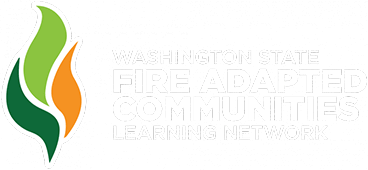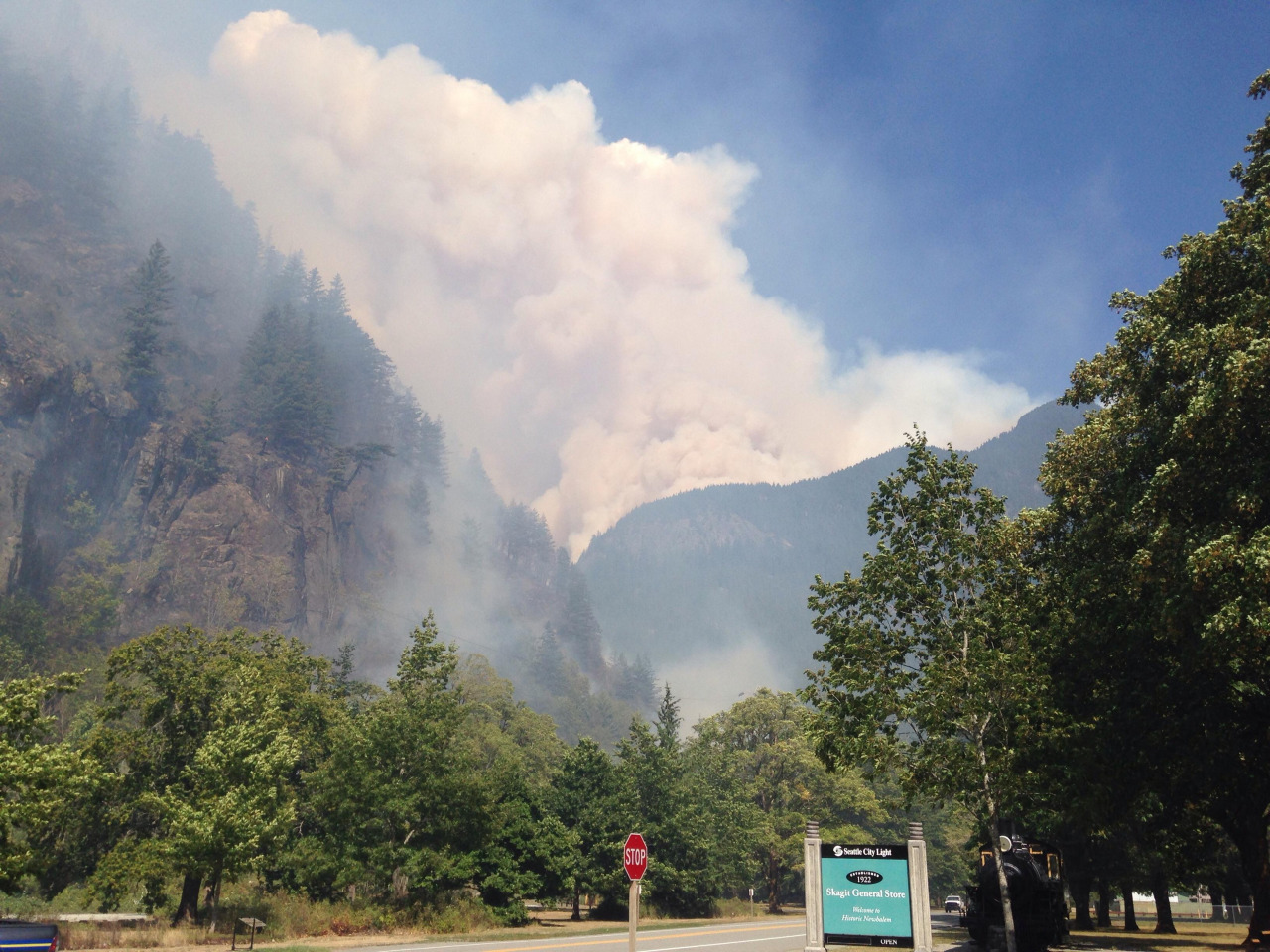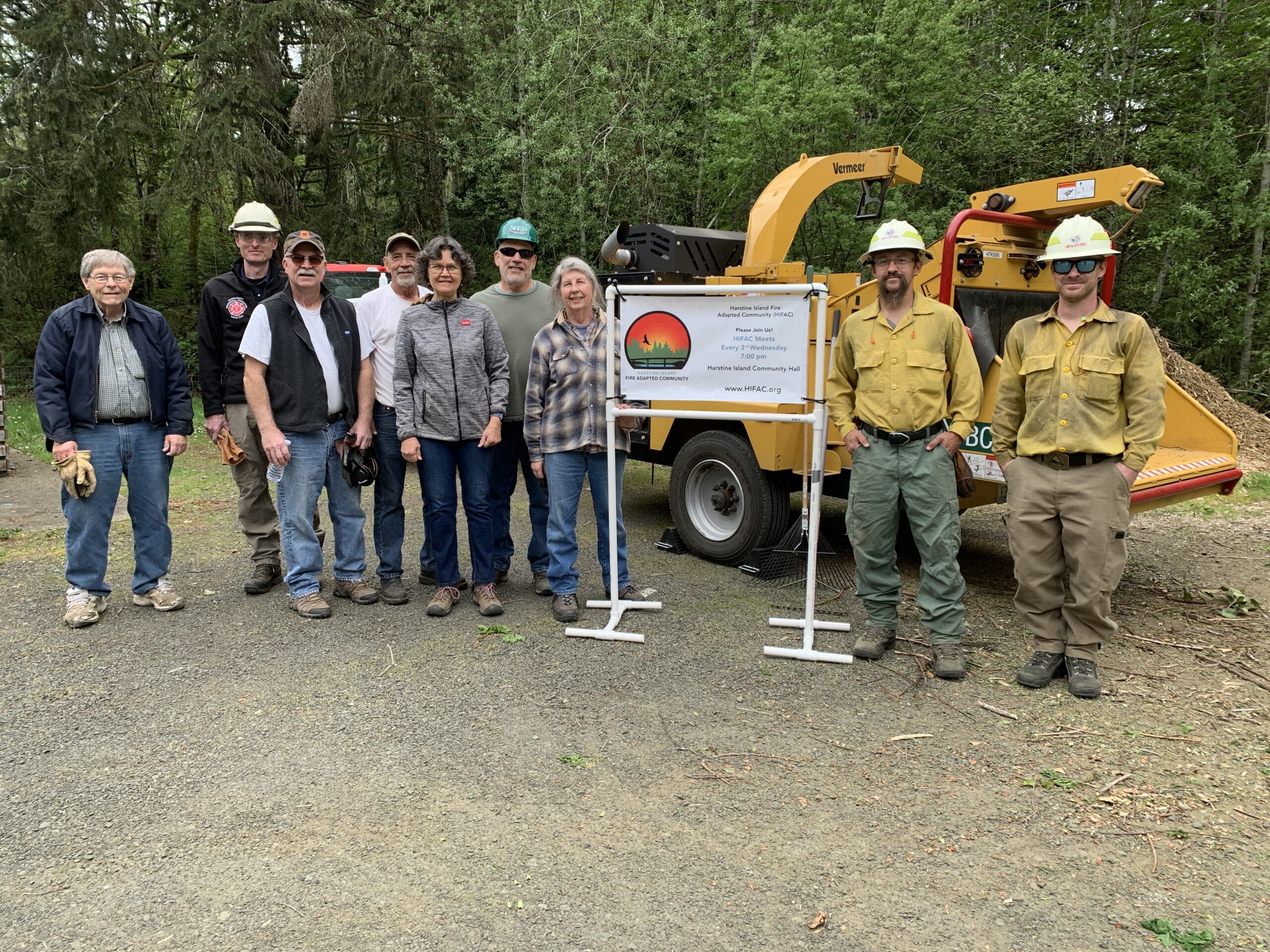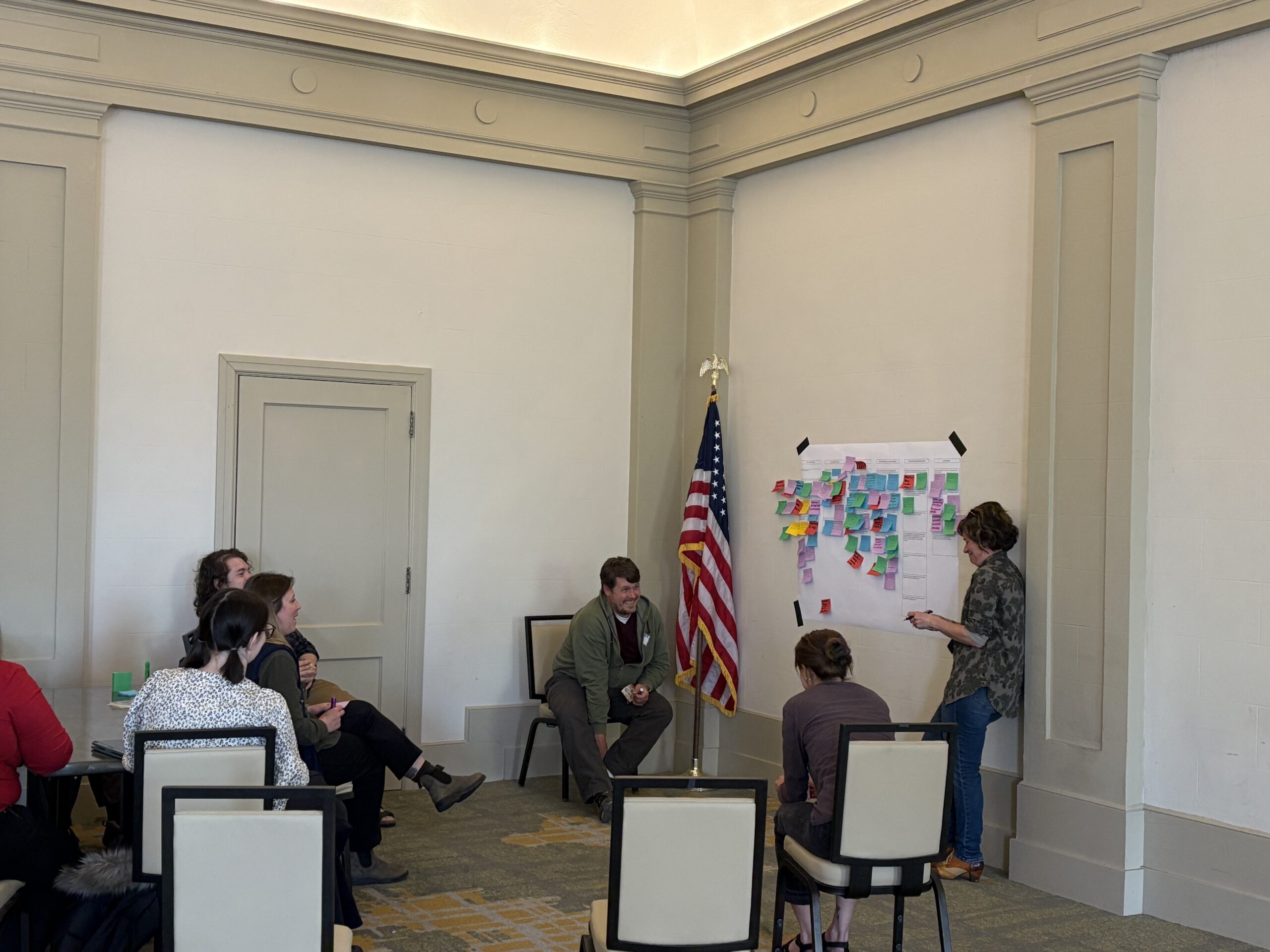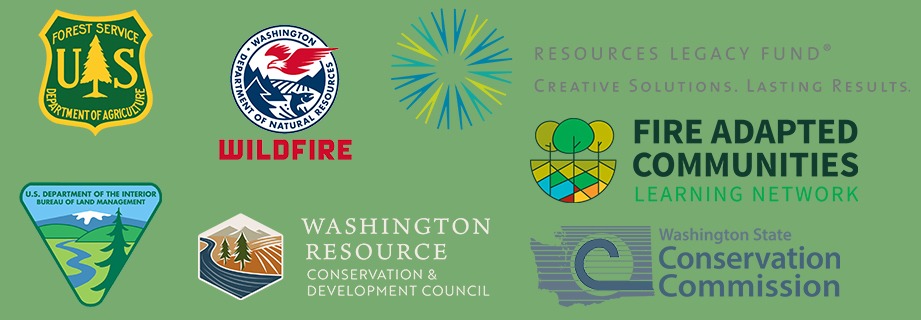Seattle City Light’s company town of Newhalem and Highway 20 in the foreground with smoke from the Goodell Creek Fire on the steep terrain in the background.
In August of 2015 the Goodell Creek Fire (ultimately the Skagit Complex) started with a lightning strike on North Cascades National Park land adjacent to the two Seattle City Light (SCL) company towns of Newhalem and Diablo where a series of hydroelectric dams generate about 20% of the City of Seattle’s electricity using the power of the Skagit River. The fire went from a slow smolder to an actively moving, highway and river jumping wildfire threatening the two towns and critical infrastructure. In the history of Seattle City Light’s Skagit Hydroelectric operation there had never been a wildfire of that magnitude. Like all wildfires in the wildland urban interface, this one had its own unique story. WAFAC Staff liaison Jennifer Coe decided to interview Cody Watson; Seattle City Light Fire Chief for Newhalem & Diablo, to get an inside perspective on the details of dealing with the fire.
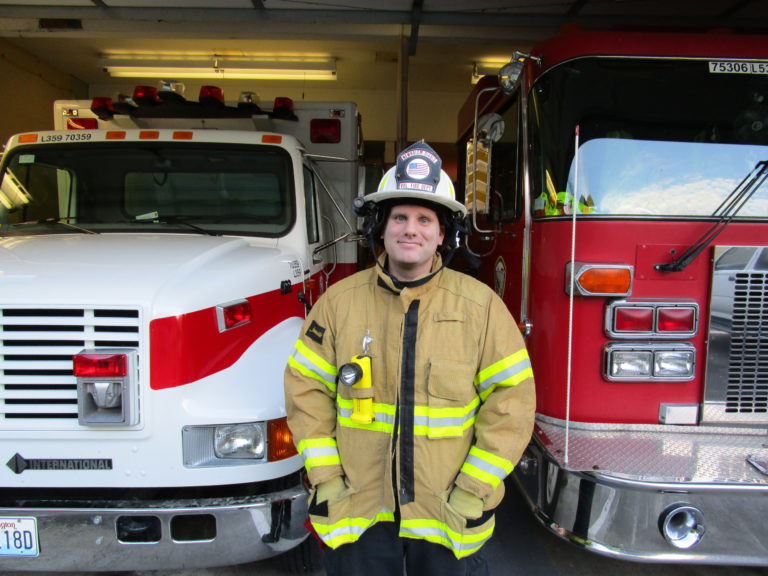
Jennifer (WAFAC): What does your job entail as Seattle City Light’s Fire Chief for the towns of Newhalem & Diablo? I imagine that being a fire chief for a utility must require some unique skills.
Cody: My position is actually fairly new, having been created almost two years ago. My day to day activities revolve around making sure our emergency teams are ready to respond at a moment’s notice. This means I ensure they have the right training, and the equipment is operational. Our emergency teams are rockstars; I just do my best to help makes sure they can get the job done as safely and easily as possible.
Part of my job has a life safety & preparedness aspect. I make sure that our fire protection and alarms get inspected and our AED’s are maintained. I am currently working on emergency evacuation plans for both towns. After last year’s fire, we want to make sure we do everything we can to keep residents, visitors, and workers safe.
Did the Goodell Creek Fire/Upper Skagit Complex change the way you view wildfire risk to SCL and the surrounding areas?
I definitely have a new appreciation for the raw destructive power that wildfires have. The speed of which conditions change is incredible! We watched the Goodell Creek fire smolder for days and then it exploded and jumped Highway 20 and the Skagit River!
I have to admit that prior to the fire, even though I had identified wildfire as a risk, I had no idea how complex and massive the situation would be. It is truly humbling. I never envisioned something that big or that fast so close to our facilities. There were some doubts and disinterest when I brought up the need for wildfire mitigation before the Goodell Creek fire; not so much anymore. Everyone here is very aware of how lucky we were that things didn’t turn out worse. Everyone has a greater appreciation of the destructive force of a wildfire, including myself.
Had you done anything ahead of time to address wildfire risk?
Yes. 3 years ago prior to the fire we decided to pursue the Firewise Communities/USA program with guidance from the Skagit Conservation District. We implemented some defensible space projects around some critical infrastructure using SCL’s vegetation management crews. The crews learned about defensible space and fire-resistant plants, so they were familiar with those concepts ahead of time, which then made it easier to quickly implement defensible space around additional structures during the fire that hadn’t yet been treated.
Coincidentally, SCL had joined the Washington Fire Adapted Communities (WAFAC) Learning Network just a few months before the fire broke out. Members of the WAFAC Learning Network had heard that Diablo was being evacuated and were trying to reach me about Mazama/Winthrop being evacuated at the same time, so that we knew not to evacuate people that direction. Although I didn’t get this information until after the fact, I think it is still a great example of how useful these types of organizations can be! Being part of the network has helped us set some framework for how to move forward in recovery and better prepare for the next time. It has also provided support and resources as we work through this process.
We also had started down a path of better networking with our neighboring agency, the National Park Service. The months prior to fire, we had unprecedented inter-agency cooperation and communication. I strongly believe it was these interactions that built trust and understanding which led to greatly improved operational success during the fire.
In the spring I was connected with a Seattle Public Utilities employee who is in charge of a wildland initial attack crew that protects the Cedar River Watershed, where Seattle gets its drinking water. This was a very valuable resource I never knew existed! I was in constant communication with them about wildland issues. During the fire, he and one of his engine crews came up and assisted us with infrastructure protection.
Is there anything you are doing at SCL and in the towns of Newhalem and Diablo after the fire to recover and/or be better prepared to respond to the next one?
We just joined the Ready, Set, Go! Program to better prepare residents in the event of an evacuation. Last year we had to evacuate the town of Diablo because of the Goodell fire and that was something that we had never prepared for. Luckily, Seattle City Light’s Incident Management Team (IMT) based out of Seattle really came through and did an extraordinary job at making sure all the residents and workers were safe and had a place to stay. Initially, the plan was to evacuate East to Winthrop but that had to change suddenly when Winthrop was getting evacuated because of another wildfire! The IMT did a great job coming up with a new plan and re-routing the evacuation to Wenatchee. This year we are taking steps to expand the IMT to the Skagit River Hydroelectric Project so we have more of a capacity to handle these large scale incidents.
We are continuing to participate in the Washington Fire Adapted Communities Learning Network. This has been a great learning tool for how other communities are dealing with becoming fire adapted and sharing with them what has worked for us (or hasn’t!). The communities are all over the state and each have their own set of challenges. But there is something encouraging about sharing your learning experiences with others who are trying to accomplish similar things!
The Firewise projects are still important to us and probably even more so after last year. We are fortunate that we have very skilled workers here at the Skagit Hydroelectric Project that specialize in vegetation management (i.e. fuel reduction). We have even done some collaborative projects with the National Park Service and North Cascades Institute! It is encouraging to see that other agencies are taking wildfire on the Westside of the state seriously.
My colleague, Dr. Crystal Raymond, in Seattle City Light’s Environmental Affairs department is working on a project with the North Cascades National Park and the Forest Service to do some fuels treatment modeling for keys in the park and near Seattle City Light’s infrastructure. This project is funded through the WAFAC Learning Network. It is important to have some science to guide our work in order to ensure that what we are doing is most effective!
Has your job changed as fire chief since the fire occurred? How?
Yes and no. My primary duty is to protect people, property, and environment, so in that sense nothing has changed; however, it is safe to say my priorities have shifted to take into account that wildfire is a very serious and real risk. I dedicate more of my time to wildfire preparedness and planning now that I’ve experienced the reality of a wildfire in my “backyard”.
I have also become a “wildfire awareness” advocate these days. I take on this role both internally and externally to my organization, trying to make people more aware of the threats and consequences of wildfire. When I hear people say that Westside forests are “asbestos forests” because they don’t burn, I know more than ever that isn’t the case. Under the right conditions our forests burn too, and unfortunately last year we experienced those conditions first hand.
